What is CMMS? Meaning, How it Works, Benefits & Limitations
CMMS means Computerized Maintenance Management System. It is a software developed to optimize the management and maintenance of physical assets within a built environment.

Initially, it catered mostly to manufacturing, petrochemical, power generation, and construction companies in the industrial sector. As buildings and stores grew in the following years, the old industrial maintenance system was updated to manage them as well.
The CMMS was initially designed to focus solely on reactive maintenance. It is a central place for maintenance teams to store data on assets, work orders, maintenance schedules, inventory, and performance metrics.
For the most part, maintenance planners, schedulers, and technicians use the CMMS software to manage maintenance operations.
Its ability to manage facility management operations—such as machinery, spare parts, and maintenance schedules—was a significant improvement over the previous pen-and-paper methods. However, it falls short of meeting the complexities of the property operations industry in the 21st century.
Related article: Why Maintenance Management Systems Aren’t Solely Used for Building Maintenance
CMMS - Origin and Evolution
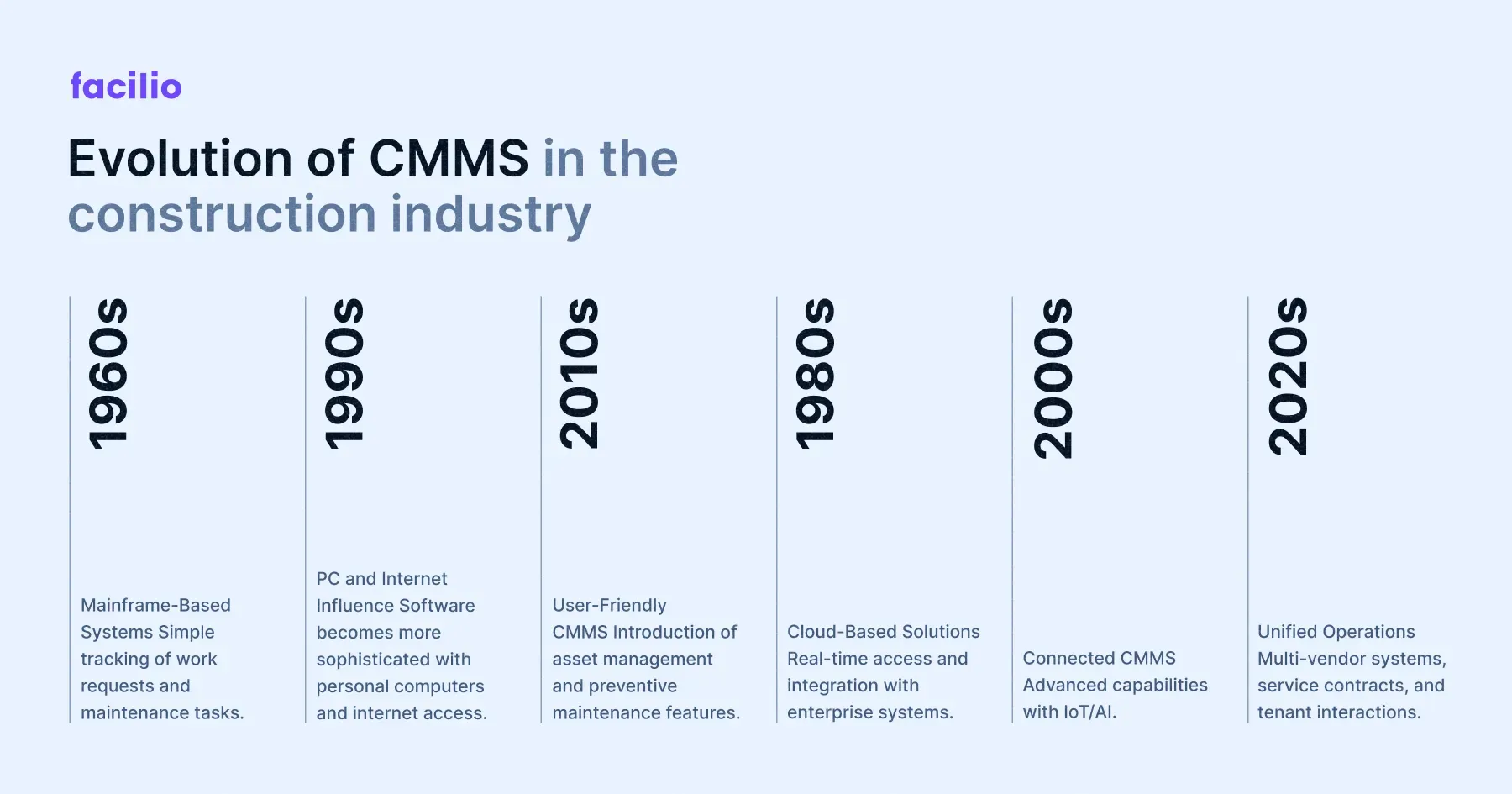
- CMMS solutions or CAFM solutions trace their origin to the 1960s. Initially, they used to be a simple mainframe-based system for tracking work requests and maintenance tasks.
- Over the next few decades, they evolved into a more sophisticated form of software — primarily so because of the advent of personal computers and the internet.
- And, in the 1990s, CMMS systems became more user-friendly and accessible. Besides, it also incorporated many other key functions like asset management and preventive maintenance — tasks that were handled manually till then.
- The 2000s saw the rise of cloud based solutions. They offered real-time access and integration with other systems for tasks like enterprise asset management.
- Today, modern CMMS platforms have evolved into connected CMMS or connected CAFM software. They offer significantly enhanced capabilities than a legacy CMMS software always offered.
For instance, Facilio’s connected CMMS uses state-of-the-art technologies like IoT/AI and does things 10x more efficiently than a legacy CMMS could ever do.
It can juggle between tools to keep track of multi-vendor building systems, varied service contracts and diverse touch points with tenants.
Get in touch today and let us help you choose the best CMMS solution for your organization.
What are the key functions of CMMS?
For industries steeped in production—manufacturing, oil and gas, utilities— CMMS as a technology was a game-changer. These sectors have a large number of tangible assets with predictable maintenance cycles. They found CMMS a tool perfectly aligned with their operational needs. For them, CMMS performed many key functions include:
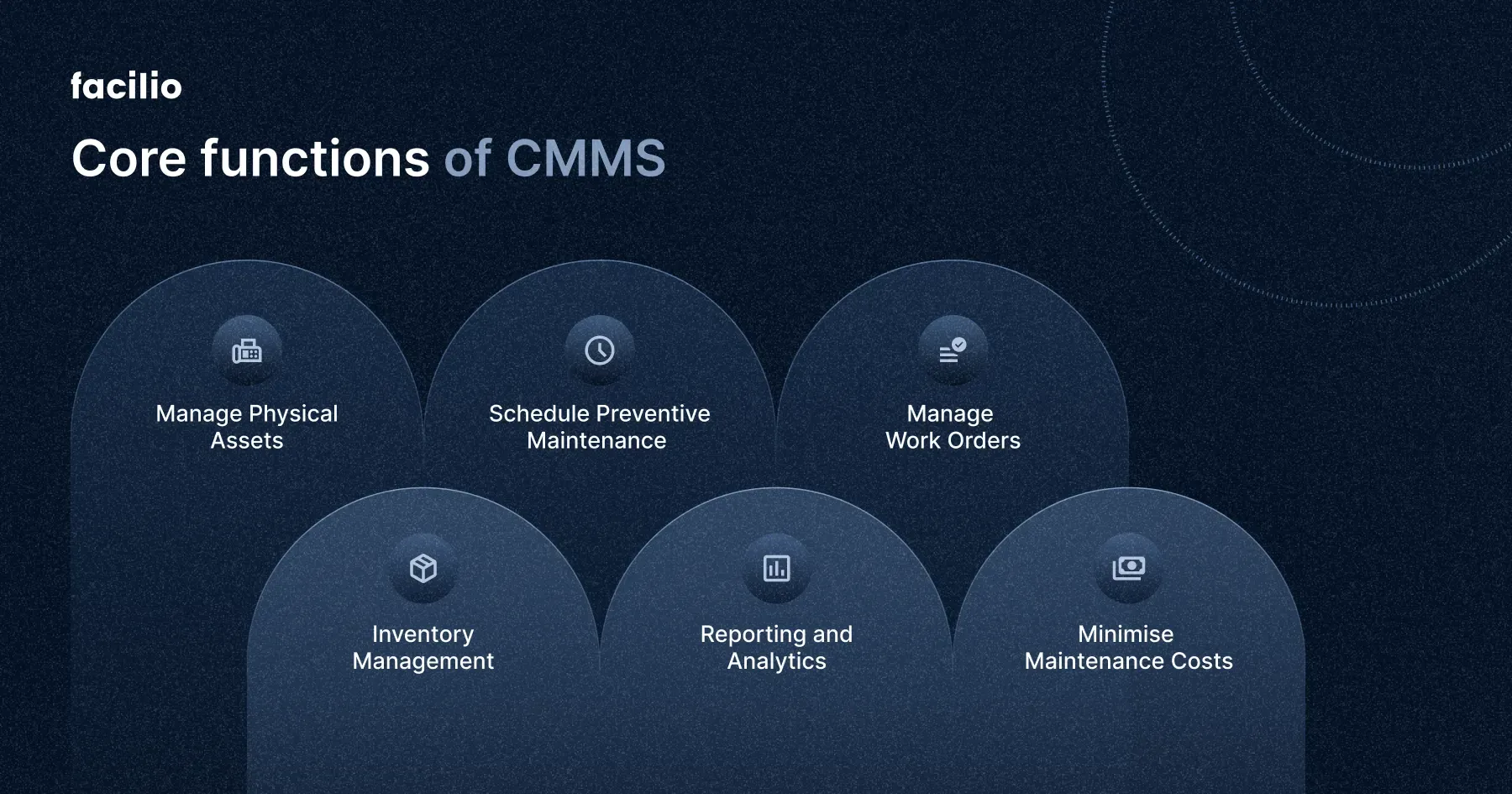
- Managing physical assets: CMMS keeps detailed records of all the equipment and assets, including their history, condition, maintenance needs, their location and history.
2. Preventive maintenance scheduling: You can use CMMS to schedule regular check-ups and maintenance tasks to prevent equipment from breaking down unexpectedly. This can include routine inspections or replacing parts before they fail — effectively reducing their down time.
3. Managing work orders: It helps you create, assign, and track maintenance tasks or repairs. For example, if a machine breaks down, a work order can be generated to get it fixed.
4. Inventory management: It tracks spare parts and materials needed for maintenance and ensures that you have the right items available when needed.
5. Reporting and analytics: The CMMS software shares reports and data on maintenance activities whenever you need them. It helps you better understand the performance, save time and identify areas where things can be improved.
6. Keep maintenance costs in check: With a maintenance management system CMMS around, you can monitor and track maintenance costs. Besides, you also get detailed reports to manage budgets and identify cost-saving opportunities in your maintenance strategy.
What are the types of CMMS? (On-Premise vs. Cloud-Based CMMS)
CMMS software can be classified into two types based on where they are installed and operated.
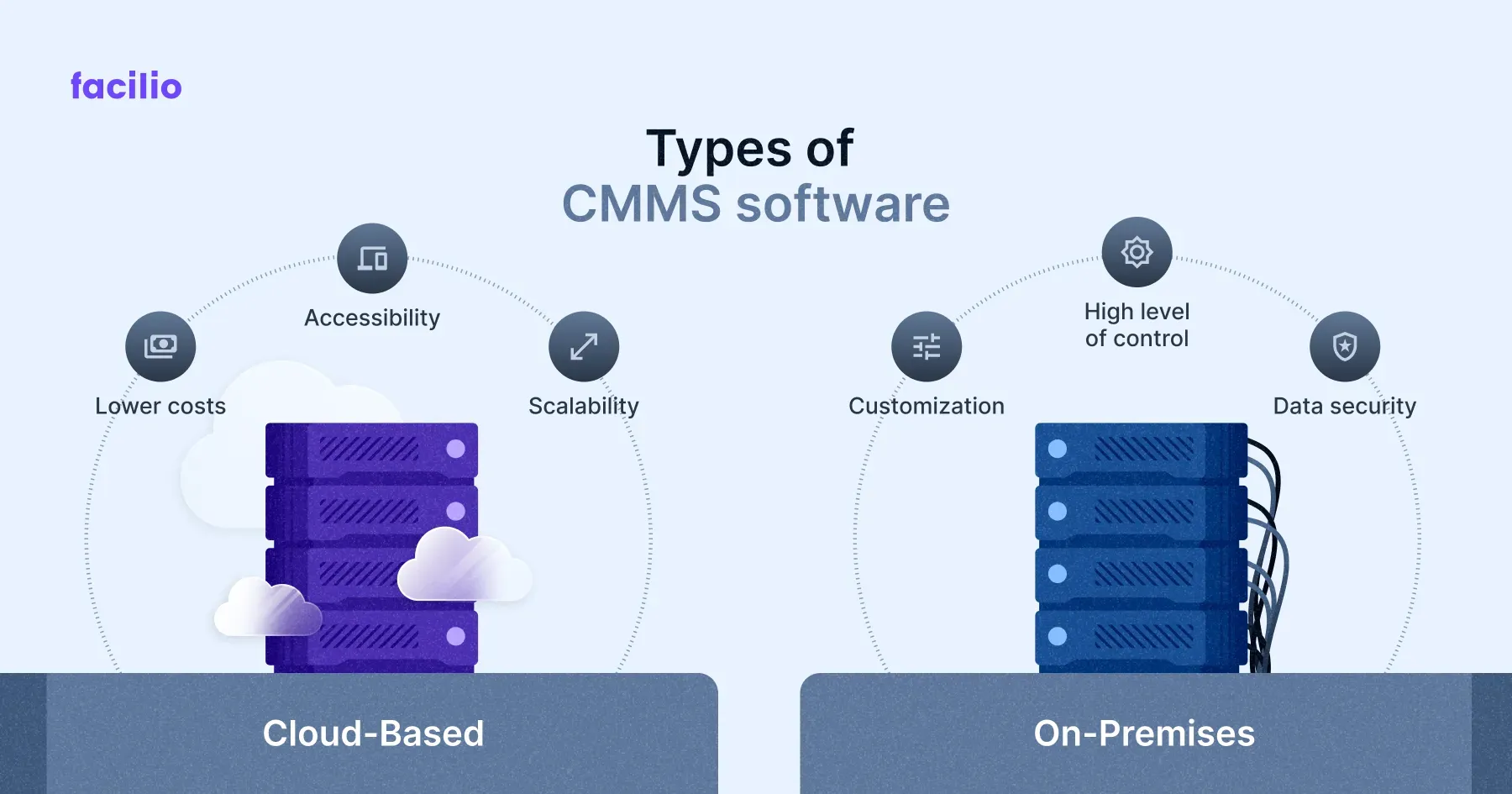
On-Premise CMMS Software
- Software is installed on the organization's servers (of course it is on premise)
- Over here, the data is stored locally within the organization's network.
- Significant upfront investment in hardware, software, and IT personnel is needed.
- It offers a high level of control over data security and customization.
- It may be more suitable for organizations with stringent data security requirements or those who prefer complete ownership of their software.
Cloud-Based CMMS Software
- Over here, the software is hosted on a remote server and accessed through the internet.
- Data is stored in the cloud and accessible from any device with internet connectivity.
- It has lower upfront costs and reduced IT overhead.
- The vendor provides automatic updates and maintenance.
- Scalability to accommodate growing business needs.
- May have concerns about data security and reliance on internet connectivity.
Who needs a CMMS?
CMMS software offers a great deal of benefits to stakeholders across various sectors. We have listed some of the benefits of a CMMS software here.
1. Facility managers in various industries (Offices, healthcare, manufacturing, etc.): Facility managers in these industries can bring together maintenance operations, reduce equipment downtime, and optimize resource allocation. As CMMS offers real-time monitoring and analytics, it can pave the way for proactive maintenance and better enterprise asset management (EAM).
1. Facility managers in various industries (Offices, healthcare, manufacturing, etc.)
Facility managers in these industries can bring together maintenance operations, reduce equipment downtime, and optimize resource allocation. As CMMS offers real-time monitoring and analytics, it can pave the way for proactive maintenance and better enterprise asset management (EAM).
2. Property managers of commercial or residential buildings
With a CMMS by their side, property managers can do it all — handle maintenance requests, schedule preventive maintenance, and manage building systems easily. In fact, a connected CMMS gives them centralized control and data insights using which their O&M teams can improve tenant satisfaction and operational efficiency.
3. Large conglomerates / FM directors
Facility management directors in large companies can oversee multiple facilities and assets from a single platform. It helps them get complete visibility across their portfolio, eliminate technology bottlenecks and bring greater control over facility operations.
4. Educational institutions (Schools & Universities)
Educational institutions can manage campus facilities, including classrooms, labs, and dormitories. With a modern, connected CMMS on board, they get timely maintenance, safety compliance, and optimal learning environments.
5. Multi & Super specialty hospitals
Maintaining critical medical equipment and facility infrastructure becomes so much easier for healthcare providers, especially multi-specialty hospitals when a connected CMMS is around. It helps them comply better with healthcare regulations, improve patient safety, and reduce the risk of equipment failure.
6. Non-food retail
Retailers like DFS, Sofology, Dunes and Robert Dyas can easily manage store maintenance, display units, and HVAC systems. It gives their patients a pleasant shopping experience while also drastically minimizing operational disruptions.
7. Commercial office owners
Commercial office building owners can maintain common areas, HVAC systems, and other shared facilities.
How to choose the right CMMS?
Selecting the right CMMS is crucial for optimizing facility management and can make a significant difference in your O&M team’s performance. We collaborate with several facility management companies, including Australia’s largest commercial real estate firm, Investa Property Group.
We interviewed Paul Vandervlis, Director of Facility Management at Investa, to share the best practices for evaluating CMMS software. Here’s what he shared.
5 steps to find the right CMMS software
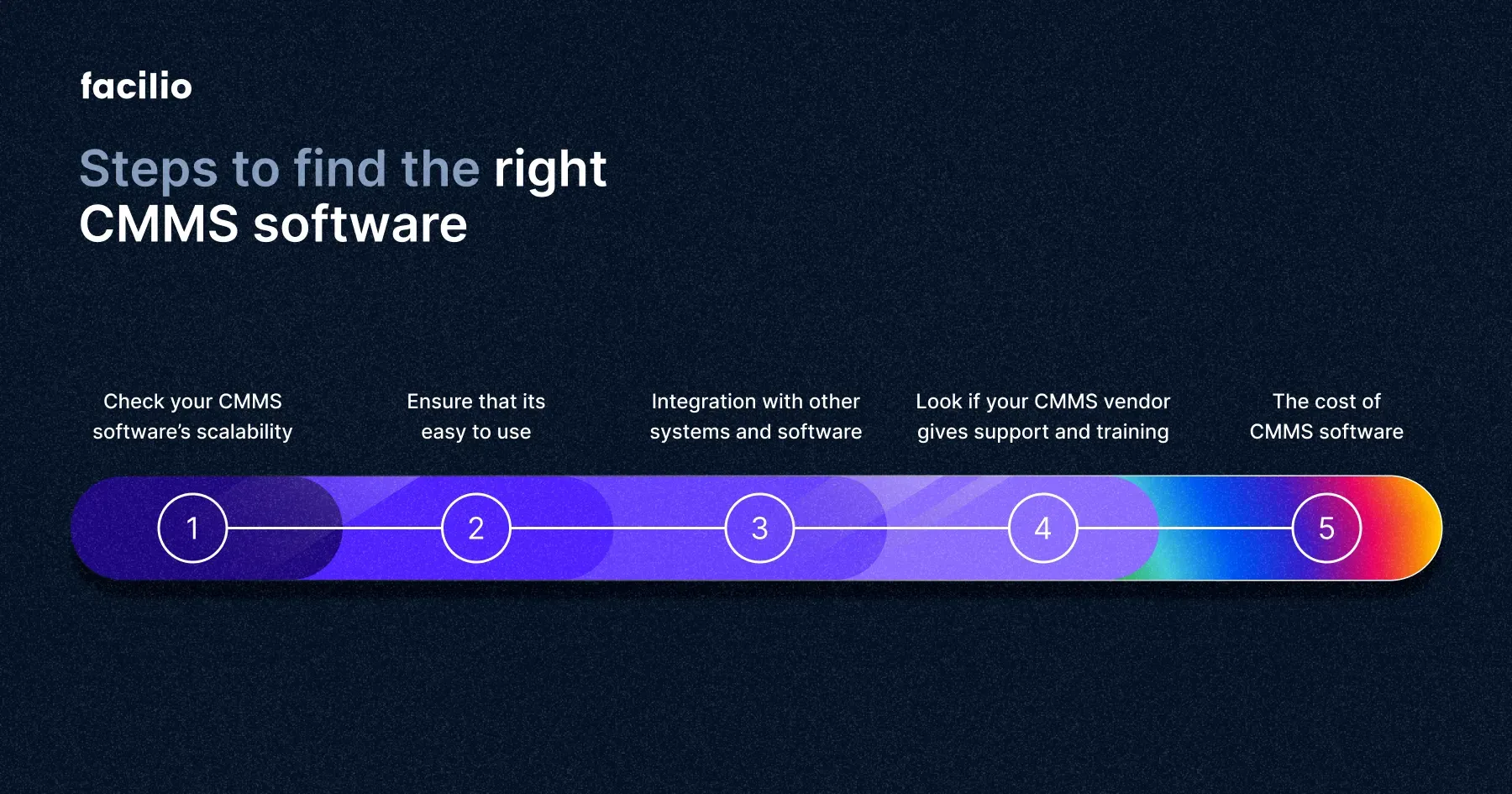
- Check your CMMS software’s scalability: Scalability of a CMMS is so crucial for facility management businesses. The CMMS software you choose should continue to meet your needs as your business expands. It should accommodate your organization's growth. Ensure it can handle increased asset volume, user numbers, and workload.
- Ensure that your CMMS is easy to use: For a team that's not tech-savvy, it's crucial to choose a CMMS with a user-friendly interface. This will greatly improve adoption rates and minimize training time. Besides, you should also consider both the complexity of your maintenance operations and the technical skills of your team when making your CMMS choice.
- Integration with other systems and software: Look for a CMMS that seamlessly integrates with other systems like ERP, HR, and IoT devices to streamline workflows. Integrations enable real-time data sharing, reduce manual data entry, and ensure all your systems work together efficiently and in sync with each other.
- Look if your CMMS vendor gives support and training: One of the reasons why CMMS software is not used to its fullest potential is lack of training to field level workers. Strong support and training are crucial because they ensure your team can effectively use the software, troubleshoot issues quickly, and maximize the system's potential. So make sure you evaluate the vendor's support options. This should ideally include things like implementation assistance, training, and ongoing support.
- The cost of CMMS software: Consider the total cost of ownership, including licensing, implementation, training, and ongoing maintenance. It's important that you factor in these costs to ensure the solution fits within your budget while also delivering long-term value.
A checklist to evaluate the right CMMS software
We have made the following checklist to help you compare and contrast the different CMMS software. You can also download the printable version of the CMMS evaluation guide to identify and choose the best CMMS software for your needs.
See how a powerful CMMS solution works in action.
Schedule a call today!
How much does a CMMS cost?
The cost of a CMMS software is not fixed. Because, the pricing of a CMMS differs based on factors like the features, number of users, and deployment type.
But, on average, an entry level cloud-based CMMS solution can range from $30 to $150 per user per month. On the other hand, an on-premise solution might include a one-time license fee starting around $10,000, plus additional costs for implementation, training, and support.
Custom pricing may also apply for large organizations or those with specific needs.
What are the benefits of CMMS?
The conventional CMMS platform offers some benefits in managing facility operations, like:
- Efficiency: It streamlines the process of managing maintenance tasks. It helps you reduce manual paperwork and helps teams work more efficiently.
- Cost Savings: By preventing equipment failures and extending the life of assets, you can save considerable money on repairs and replacements of your physical assets.
- Better Organization: It keeps all maintenance information in one place, making it far more easier to track and manage.
For instance,
However, the benefits nearly end there. Beyond being an improvement over pen and paper, or perhaps a spreadsheet, a conventional CMMS often creates more problems than it solves. Using an outdated CMMS in the real estate industry is like repurposing a slice of bread as a coaster—it may be square and prevent water rings, but it introduces a whole new set of issues.
The limitations of conventional CMMS software
As workplaces changed, so did the needs. The rise of service-oriented industries, with their emphasis on people, processes, and intangible assets, presented a new challenge. Offices, hospitals, retail stores—these environments demanded a different approach.
It wasn't just about fixing machines; it was about creating comfortable, safe, and productive spaces.
While the CMMS could manage the HVAC system, it struggled to optimize patient flow in a hospital or enhance customer experience in a retail store.
It became clear that the rigid structure of the CMMS, designed for the tangible and predictable, was ill-equipped for the dynamic and complex nature of modern facilities. The system that once drove efficiency began to act as a constraint, hindering organizations from achieving their full potential.
To succeed, businesses needed a new approach. One that focused on results, not just repairs.
While conventional CMMS served its purpose in industrial settings, it falls short in meeting the needs of modern commercial facilities for several reasons:
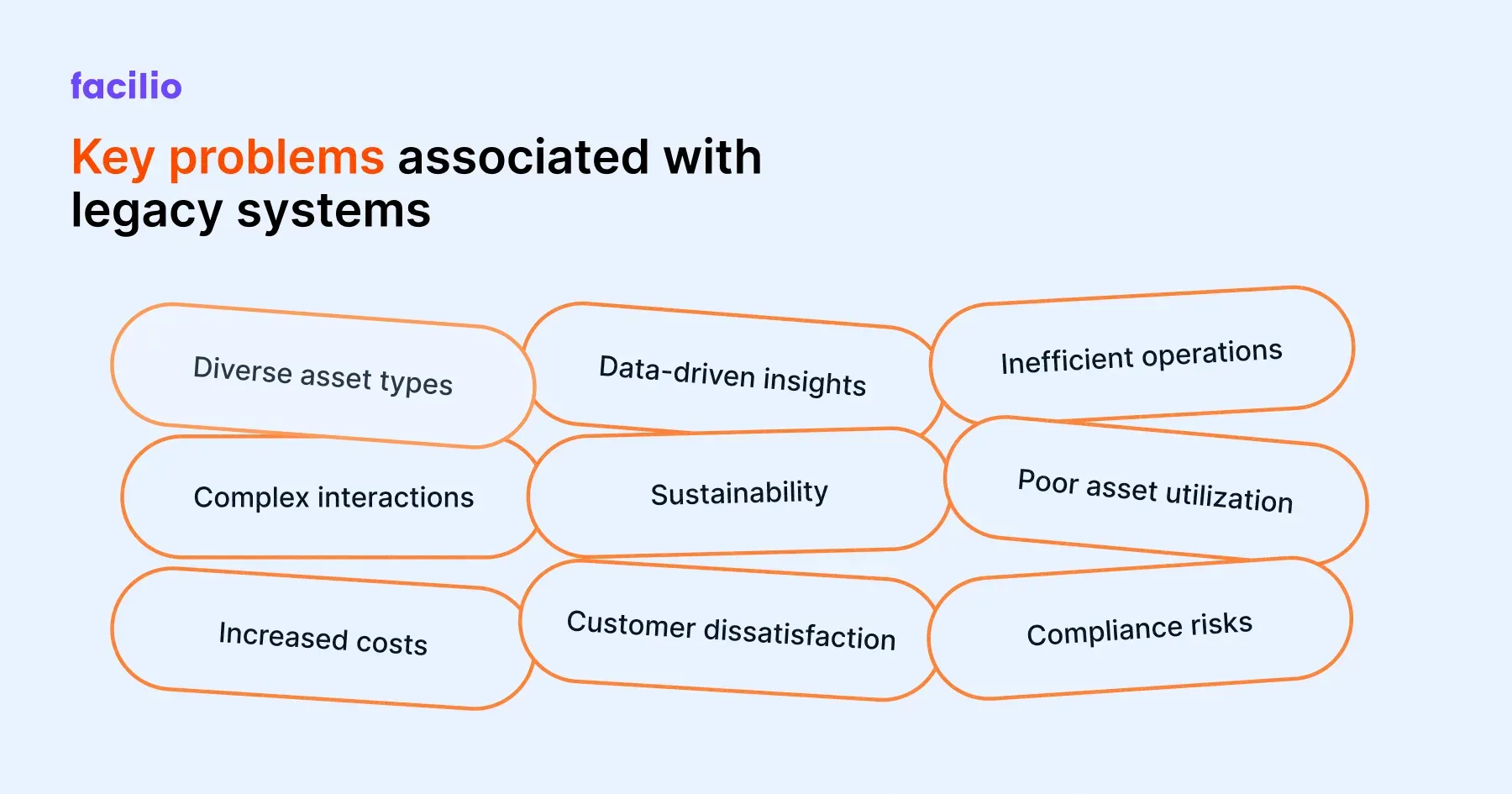
- Diverse asset types: Commercial facilities have a broader range of assets, including HVAC systems, elevators, lighting, security systems, and IT infrastructure, each with unique maintenance requirements.
- Complex interactions: Assets in commercial facilities interact with each other and the environment in complex ways, making it difficult to predict failures and optimize maintenance.
- Data-driven insights: Modern facilities generate vast amounts of data, which can be leveraged to improve operations and maintenance. But traditional CMMS often lack advanced analytics capabilities.
- Sustainability: There's a growing emphasis on energy efficiency and sustainability, requiring tools to track and manage environmental performance.
- Inefficient operations: Manual processes, slow response times, and reactive maintenance.
- Increased costs: High maintenance expenses due to unplanned breakdowns and excessive inventory.
- Poor asset utilization: Suboptimal space utilization and equipment downtime.
- Compliance risks: Difficulty in meeting regulatory requirements and industry standards.
- Customer dissatisfaction: Service disruptions and facility issues impacting tenant or customer satisfaction.
The traditional CMMS gave a solid foundation for asset management. But, the evolving needs of modern commercial facilities demand a more comprehensive and flexible solution. Such a solution should go beyond maintenance and asset management to encompass facility-wide operations and performance—exactly where a connected CMMS comes into play.
Why do you need a connected CMMS?
A connected CMMS is fundamentally different from a regular, legacy CMMS software as it integrates advanced technologies like IoT, big data, and Artificial Intelligence.
Beyond its core functions of asset tracking, work order management, and inventory control, a connected CMMS offers countless benefits and has a much broader scope like:
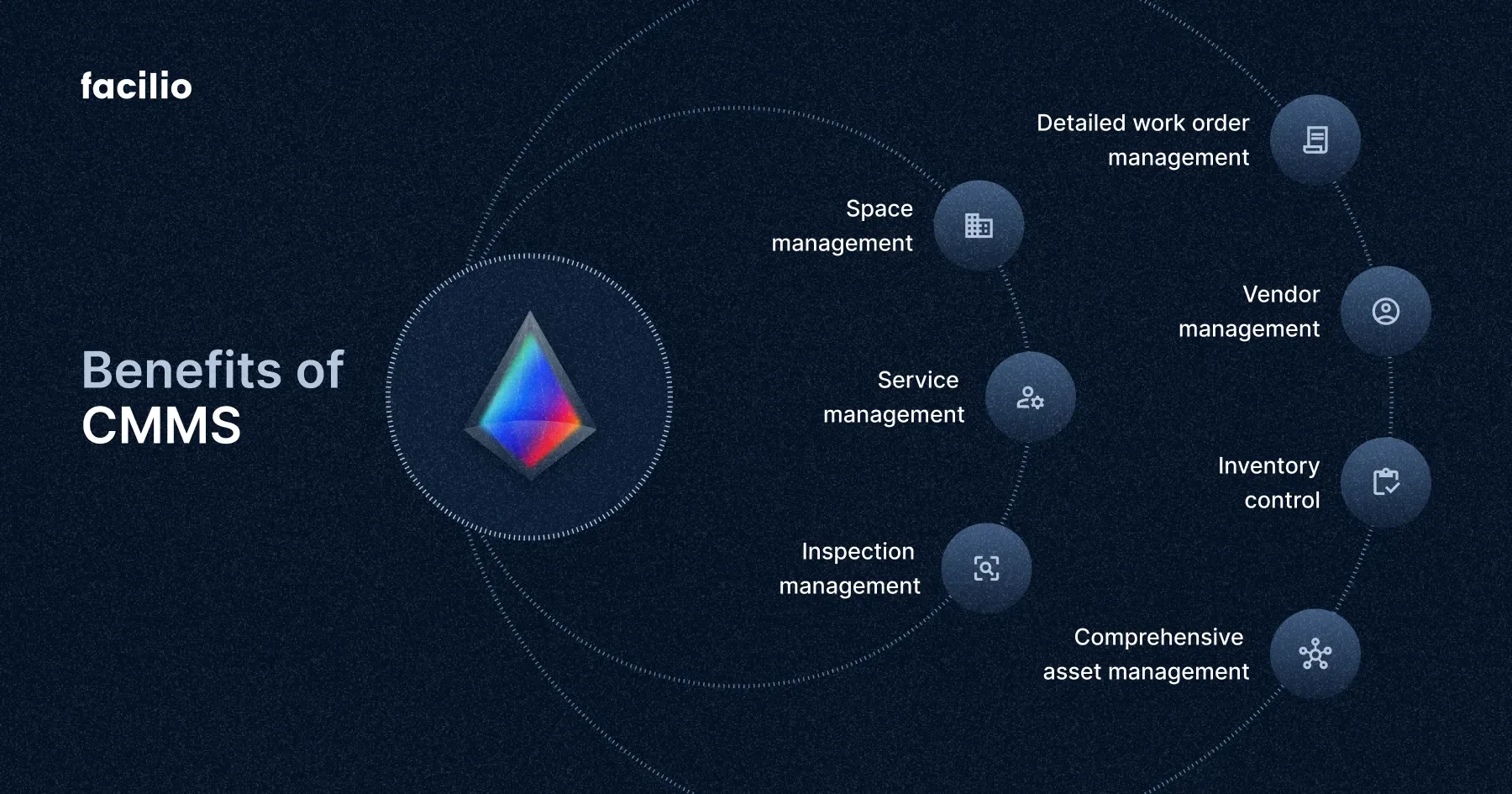
- Comprehensive asset management: Tracking not just equipment but also spaces, facilities, and their associated information.
- Detailed work order management: Recording not just work order details but also associated costs, performance metrics, and technician information.
- Inventory control: Managing spare parts, consumables, and equipment inventory levels, optimizing stock levels, and reducing costs.
- Vendor management: Tracking vendor performance, managing contracts, and facilitating efficient procurement.
- Inspection management: Scheduling and executing inspections, generating inspection reports, and ensuring compliance.
- Space management: Optimizing space utilization, tracking occupancy, and managing facility layout.
- Service management: Coordinating service requests, assigning tasks, and tracking service delivery.
Streamline your facility management operations with Facilio connected CMMS
Facilio is the most advanced, comprehensive connected CMMS software developed yet.
Among the many CMMS solutions available in the market, Facilio's connected CMMS stands out with its holistic approach. Its IoT-led property operations platform establishes maintenance workflows, monitors energy consumption, manages vendors and payments, and triggers preventive maintenance notifications at the right time.
Facilio takes a unique approach to property operations and maintenance (O&M), unifying people, systems, and processes.
This transcends the conventional limitations that standard CMMS solutions offer. It can deliver enhanced stakeholder engagement and system efficiency—all in one unified platform.
Case study: Learn how Facilio helped the Dubai World Trade Center achieve end-to-end digital transformation
DWTC One Central, in the heart of Dubai's new Business District, spans 1.7 million square feet and offers premium office and retail spaces. Focused on the UAE’s 'Net Zero by 2050' vision, the DWTC One Central is committed to building a low-carbon economy. To achieve this ambitious transformation, they partnered with Facilio.
We deployed our Connected CMMS alongside an IoT-driven Connected Buildings solution, empowering them on their path to sustainability.

Dubai World Trade Center's Challenges
- Lack of real-time insights: Without a centralized system, DWTC struggled with limited visibility and data access.
- Energy and sustainability hurdles: Disconnected processes hindered efforts to improve energy efficiency and meet sustainability goals.
- Regulatory penalties: Temperature inconsistencies led to penalties, underscoring the need for better compliance.
- Missed maintenance opportunities: Limited data insights prevented proactive measures to reduce downtime and energy anomalies.
To address these complex challenges and future-proof operations, DWTC One Central required a centralized property management solution that leveraged the Internet of Things (IoT) and artificial intelligence (AI).
Here's what Rami Alaileh, AVP for Destination Management, Dubai World Trade Centre has to say about Facilio's solution.
"Exceeding the highest benchmarks for sustainable design and construction has been a top priority for us right from the start. DWTC supports the UAE’s sustainability agenda and our deployment with Facilio is in line with our efforts to achieve optimal efficiency of energy consumption and operations at One Central in a sustainable manner across our facilities which include offices, hotels, shops, among others.”
رامي العلايلة
نائب الرئيس المساعد، إدارة الوجهات، مركز دبي التجاري العالمي
Facilio’s Solution
- End-to-end digital transformation for energy optimization
Facilio’s digital transformation solution leverages IoT to streamline DWTC’s building management, enhancing operational efficiency and occupant experiences, all supported by Connected CMMS for effective asset management. - Reduced penalty oversight with Delta T monitoring
Through Delta T monitoring and trend analysis, Facilio ensures DWTC complies with regulations and optimizes energy use, with real-time dashboards that help avoid penalties. - Energy-conscious operations through granular visibility
Facilio provides comprehensive insights into building performance, using energy use intensity (EUI) benchmarks to identify low performers and offering dashboards for detailed energy consumption analysis. - Optimized asset functions with fault detection and diagnostics (FDD)
Facilio’s FDD module monitors asset performance and converts critical alarms into actionable work orders. This helped them by enabling proactive maintenance that ensures optimal asset functionality through Connected CMMS.
Impact on DWTC's Business
- Accelerated the path to net-zero operations by enhancing control and accountability over energy consumption across the portfolio.
- Eliminated unnecessary penalties through meticulous monitoring of chiller Delta T compliance.
- Enhanced equipment performance while minimizing the risk of failure.
- Boosted tenant satisfaction with swift fault remediation and precise error reporting.
- Achieved greater operational efficiency by decreasing customer escalations and reducing man-hours.
- Identified 8% energy wastage within just three weeks of implementation.
Interested in learning more about Facilio’s Connected CMMS?
Book a demo with our product expert today!
Frequently asked questions
1. What does CMMS stand for?
CMMS means Computerized Maintenance Management System. It is a software used to manage and streamline facility maintenance tasks, schedules, and asset tracking.
2. Who needs a CMMS?
Any organization or entity that works within a built environment with assets that need regular maintenance need a CMMS. It includes manufacturing plants, hospitals, facilities management, commercial real estate, and facility management companies.
3. How does CMMS software work?
CMMS software works by automating maintenance management. It does it by tracking work orders, scheduling tasks, managing inventory, and providing insights through reports and analytics. All of it ensures that your assets operate at peak performance over time.
4. Is CMMS the same as ERP?
No. The CMMS mainly focuses on maintenance management. It helps manage work orders, track assets, schedule preventive maintenance, manage inventory, and generate maintenance reports. ERP (Enterprise Resource Planning), on the other hand, is a broader system that integrates various business processes, like finance, HR, supply chain, etc.
5. What is the difference between CMMS and EAM software?
CMMS is primarily used for maintenance management, while EAM (Enterprise Asset Management) software covers the entire lifecycle of assets, including acquisition, operation, maintenance, and disposal.
6. How do I choose a CMMS software?
To choose a CMMS, you can consider factors like ease of use, scalability, integration capabilities, vendor support, and total cost of ownership. It will ensure it meets your organization’s business specific needs in the long run.
7. What is the cost of CMMS?
CMMS costs vary based on several factors like deployment, number of users and number of features. The price of cloud-based point solutions typically range from $30 to $150 per user per month, while on-premise solutions may involve higher upfront costs and additional expenses for implementation and support.
8. What is the difference between a legacy CMMS software and a connected CMMS?
Legacy CMMS software often focuses on basic maintenance tasks. On the other hand, connected CMMS integrates with other systems and stakeholders, offering real-time data, enhanced collaboration, and better decision-making.
9. What are the key features of CMMS software?
Key features of CMMS software include work order management, preventive maintenance scheduling, inventory management, asset tracking, reporting, and integration with other business systems.
10. What is the difference between CAFM and CMMS?
CAFM (Computer-Aided Facility Management) focuses on managing facilities, space planning, and building operations, while CMMS is primarily centered on maintenance management of assets and equipment.
11. What are the industries that benefit from CMMS?
Industries like manufacturing, healthcare, facilities management, utilities, and real estate benefit from CMMS by improving maintenance efficiency, reducing downtime, and extending asset life.
12. Why do CMMS fail?
CMMS implementations often fail due to lack of management support, poor user adoption, inadequate training, and selecting a system that doesn’t align with the organization’s needs.



